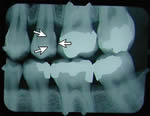 Computer
Digital Radiography (CDR) Computer
Digital Radiography (CDR)
Dental X-rays can now be taken using sensors that transmit
the image directly into a computer monitor. This larger
image helps the patient understand the doctor's explanations
more easily and enables the doctor to "zoom in"
on a specific area of the tooth. An important advantage
to this new technology is that it reduces the amount
of radiation by 90%. Digital X-rays are also faster.
The digital image only takes 20 seconds to appear in
the monitor. In addition, this new technology is friendly
to the environment since no chemicals are needed for
developing the image.

What are Dental X-rays?
What most people call X-rays are actually X-ray photographs
(also known as radiographs). An image is made using
X-rays, which are similar to sunlight, but of a shorter
wavelength, and able to show us what's below the surface
of a tooth. Even though we call them X-rays, we are
actually referring to the image created by X-rays.
Why are Dental X-rays Necessary?
X-rays are the only way to identify problems that aren't
externally visible. X-rays are very essential in doing
a complete and thorough dental examination. They are
especially important in diagnosing serious conditions
early to allow for effective treatment before
you experience discomfort. X-rays show bone anatomy
and density, decay between
the teeth or how extensive the decay is, whether an
abscess is present, impacted
teeth, or if children have permanent teeth.
|
|
|
|
No cavity on first X-ray.
|
Months later, cavities that
start between the teeth can't be seen by visual
examination, but they can be detected on an X-ray.
|
This cavity was detected and filled before the patient
felt any discomfort, and before the nerve became infected
or the tooth became abscessed.
There is another cavity shown in the X-ray on the right.
Can you find it? It's difficult for the untrained eye
to spot. Click here to see where it is. (Hint: It's not the
left edge of the top left tooth. That's just the edge of the
frame around the X-ray).
How Often Do I Need Dental X-rays?
The number and type of X-rays you will need depends
on several factors such as age, current dental health,
and external signs that may trigger a cause for concern.
We are sensitive, however, to your concerns about exposure
to radiation, and we only perform those X-ray procedures
that are necessary for your continued dental health.
Still Have Questions or Concerns?
If you have any questions or concerns about dental
X-rays, feel free to discuss them with any of our staff.
They are highly trained in the prudent and effective
use of dental X-rays and share your concerns about exposure
levels.
|

 Computer
Digital Radiography (CDR)
Computer
Digital Radiography (CDR)

